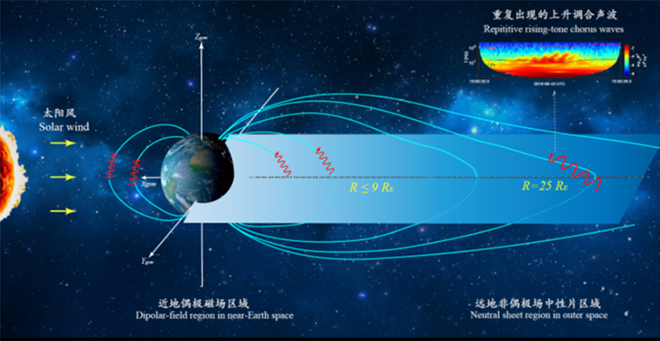
Figure Researchers discovered chorus waves in non-dipole neutral sheet regions 160,000 km from Earth.
With the support of the National Natural Science Foundation of China (Grant Nos. 41821003 and 42104164), a research team led by Academician Cao Jinbin and associated professor Liu Chengming at the School of Space and Earth Sciences, Beihang University, in collaboration with international scholars from the United States and Sweden, conducted a study on the generation and evolution of chorus waves in Earth’s magnetosphere. For the first time, they discovered that chorus waves can also emerge in the neutral sheet region of a non-dipole magnetic field located 160,000 kilometers from Earth and provided a theoretical explanation based on nonlinear wave-particle interactions. The findings were published online in Nature on January 23, 2025, titled "Field-particle energy transfer during chorus emissions in space." (Paper link: http://www.nature.com/articles/s41586-024-08402-z)
Chorus waves are among the most intense electromagnetic fluctuations in Earth’s and planetary space plasmas, playing a critical role in the acceleration of high-energy electrons in Earth’s radiation belts and the generation of pulsating auroras. These waves can accelerate low-energy electrons to high energies (megaelectronvolts, MeV), forming "killer electrons" that threaten spacecraft operations and astronaut safety. In addition, chorus waves can scatter electrons, causing them to precipitate along geomagnetic field lines into the polar upper atmosphere, where collisions with atmospheric molecules produce spectacular pulsating auroras. They can also trigger hiss waves, alter the structure of Earth’s radiation belts, modulate magnetosphere-ionosphere coupling, and influence the development and evolution of space weather.
Due to their significance, chorus waves have been a forefront research topic in space physics since the 1950s. Through nearly 70 years of satellite observations and theoretical studies, scientists have gained a relatively comprehensive understanding of chorus waves, traditionally believed to occur primarily in Earth’s near-space dipole magnetic field regions. Earth’s magnetic field lines, anchored at the northern and southern magnetic poles, act like fixed strings. When solar wind energy enters the magnetosphere and excites these "strings" through physical processes, electromagnetic waves resembling the chorus of birds at dawn are generated—hence the name "chorus waves." These waves exhibit quasi-coherent discrete spectra with frequency chirping characteristics. However, due to the complexity of plasma processes, the mechanisms behind their generation and propagation remain highly debated, with no consensus to date.
To address this, the research team conducted an in-depth study of chorus wave nonlinear theory, proposing that their generation is a fundamental plasma process that should occur not only in traditional dipole-dominated regions but also in non-dipole regions. By analyzing vast data from NASA’s Magnetospheric Multiscale Mission (MMS), they discovered, for the first time, continuous chorus waves in the magnetotail neutral sheet—a region with a non-dipole magnetic field structure. The magnetic field in this region is extremely weak (about one ten-thousandth of Earth’s surface field) and topologically distinct from dipole fields, where chorus waves were previously thought impossible. This breakthrough challenges the 70-year-old consensus that chorus waves only occur in dipole-dominated near-Earth regions.
Through theoretical calculations, the team identified nonlinear wave-particle interactions as the cause of chorus waves and, for the first time, observed key evidence—electron hole formation—providing the most direct observational and theoretical support for the nonlinear mechanism behind chorus wave generation.
In a commentary in Nature, Professor Richard Horne, Fellow of the Royal Society (FRS), noted that the discovery of chorus waves in an "unexpected region" (160,000 km from Earth) is a "surprising" result. He also highlighted the "remarkable" observation of phase-space electron holes. Since chorus waves can accelerate electrons to near-light speeds, creating satellite-damaging killer electrons and shaping Earth’s radiation belts, current space weather models for satellite protection incorporate chorus wave effects. Thus, this research not only deepens our understanding of chorus waves but also significantly enhances our ability to forecast high-energy electron radiation belts.

Add: 83 Shuangqing Rd., Haidian District, Beijing, China
Postcode: 100085
Tel: 86-10-62327001
Fax: 86-10-62327004
E-mail: bic@donnasnhdiary.org
京ICP备05002826号 文保网安备1101080035号 Copyright 2017 NSFC, All Right Reserved